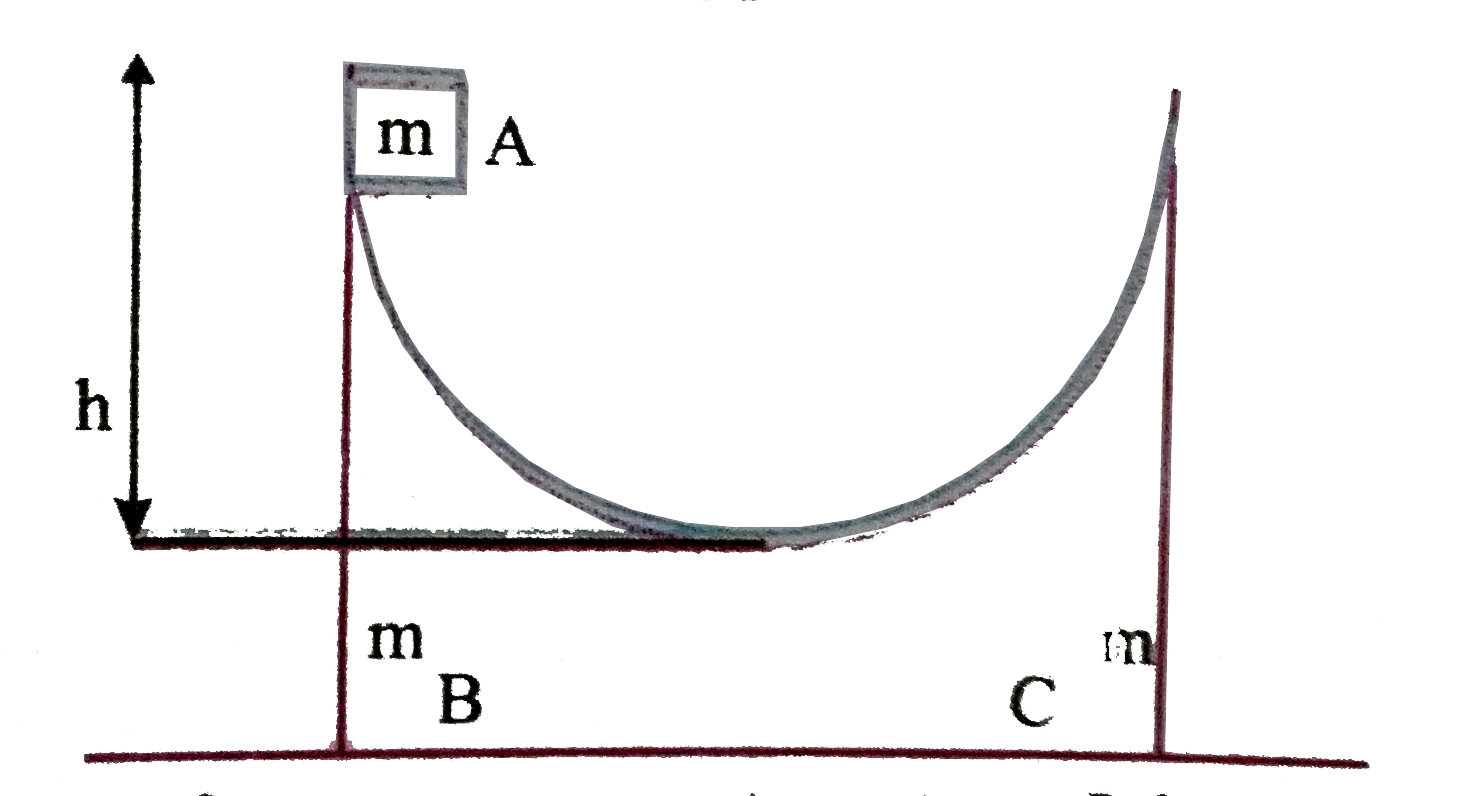A block of mass m slides down a wedge of mass M as shown . The whole system is at rest , when the height of the block is h above the ground. The wedge surface is smooth and gradually flattens. There is no friction between wedge and ground.

If there would have been friction wedge and block , which of the following quantities would still remains conserved ?
Linear momentum of the system along horizontal direction
Linear momentum of the system along vertical direction
Linear momentum of the system along a tangent to the curved surface of the wedge
Mechanical energy of the system
The correct Answer is:A
Linear momentum is conserved only in horizontal direction.
Net Fext on system is zero in horizontal direction therefore linear momentum is conserved only in horizontal direction.
Topper's Solved these Questions
- DAILY PRACTICE PROBLEMSBOOK - RESONANCE ENGLISHCHAPTER - DAILY PRACTICE PROBLEMSEXERCISE - dpp 70
7 Videos
- DAILY PRACTICE PROBLEMSBOOK - RESONANCE ENGLISHCHAPTER - DAILY PRACTICE PROBLEMSEXERCISE - dpp 71
8 Videos
- DAILY PRACTICE PROBLEMSBOOK - RESONANCE ENGLISHCHAPTER - DAILY PRACTICE PROBLEMSEXERCISE - dpp 69
5 Videos
- CURRENT ELECTRICITYBOOK - RESONANCE ENGLISHCHAPTER - CURRENT ELECTRICITYEXERCISE - Exercise
53 Videos
- ELASTICITY AND VISCOCITYBOOK - RESONANCE ENGLISHCHAPTER - ELASTICITY AND VISCOCITYEXERCISE - Advanced Level Problems
9 Videos
Similar Questions
A uniform rod AB of mass m and length l at rest on a smooth horizontal surface . An impulse P is applied to the end B. The time taken by the rod to turn through a right angle is :

View Solution
In given diagram what is the minimum value of a horizontal external force F on block A so that block B will slide on ground is .
View SolutionA uniform disc of mass 300 kg is rotating freely about a vertical axis through its centre at a constant angular velocity ω0. A boy of mass 30 kg starts from the centre and moves along a radius to the edge of the disc. Angular velocity of the disc ill now become
View SolutionSpecific resistance of a wire depends on the
View SolutionA wire loaded by a weight of density 7.8g/cc is found to be of length 100cm. On immersing the weight in water. The length decrease by 0.20 cm find the original length of the wire.
View SolutionCalculate angle of friction between wedge and block system is at rest M coefficient of friction between wedge and block.
View SolutionTwo small blcok m=2kg each kept on wedge of mass 12 kg . There is no friction between blocks and wedge coefficient of friction between wedge and ground in mu=0.3 . Calculate frictional force by ground on wedge.
View SolutionWedges B and C are smooth and they are placed in contact as shown. Block A is placed on wedge B at a height h above ground. Block and the two wedges are all of same mass m. Neglect friction every where.

The maximum height upto which block A rises on wedge C is
View SolutionWedges B and C are smooth and they are placed in contact as shown. Block A is placed on wedge B at a height h above ground. Block and the two wedges are all of same mass m. Neglect friction every where.

The velocity of A when it has slide down to ground from wedge C is
View SolutionWhen a block is placed on a wedge as shown in figure, the block starts sliding down and the wedge also start sliding on ground. All surfaces are rough. The centre of mass of ( wedge + block ) system will move.
View SolutionA block of mass m slides down a wedge of mass M as shown . The whole system is at rest , when the height of the block is h above the ground. The wedge surface is smooth and gradually flattens. There is no friction between wedge and ground. As the block slides down, which of the following quantities associated with the system remains conserved ?
View SolutionA block of mass m slides down a wedge of mass M as shown . The whole system is at rest , when the height of the block is h above the ground. The wedge surface is smooth and gradually flattens. There is no friction between wedge and ground. If there would have been friction wedge and block , which of the following quantities would still remains conserved ?
View SolutionA block of mass m slides down a wedge of mass M as shown . The whole system is at rest , when the height of the block is h above the ground. The wedge surface is smooth and gradually flattens. There is no friction between wedge and ground.

If there is no friction any where, the speed of the wedge, as the block leaves the wedge is :
View SolutionA block of mass m is placed on a smooth wedge of inclination theta & mass M. The whole system is slip on the wedge. Then the normal reaction on the wedge acting from the ground :
View SolutionA block of mass m slides down on inclined wedge of same mass m as shown in figure . Friction is absent everywhere . Acceleration of centre of mass of the block and wedge is
View SolutionA block of mass m slides over a smooth wedge of mass M which is placed over a rough horizontal surface . The centre of mass of the system will move towards left

Here μ = coefficient of friction between the wedge and the ground .
View Solution
